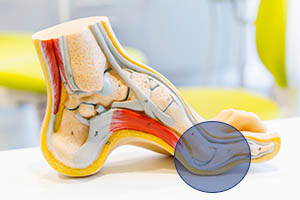
Achilles Tendon Repair & Reconstruction
The Achilles is a strong tendon situated at the back of the ankle and connects the heels to the calf muscle. Being the largest tendon in the body, it plays a vital role in helping us run, walk and move, but it can also be prone to ruptures, tears or damage.
Typically, athletes experience Achilles tendon damage due to overuse but it can also rupture due to sudden impact. As an essential part of the ankle, a damaged Achilles tendon can lead to difficulty walking, orthopaedic pain and a weakened ankle.
What is Achilles tendon repair and reconstruction?
When the Achilles tendon is damaged, it leads to various complications that affect your mobility and daily life. As a result, Dr Alexander performs comprehensive Achilles tendon repair and reconstruction to help restore functionality and comfort to the ankle. This may include repairing a rupture in the tendon or removing pieces of damaged tissue.
When is Achilles tendon repair and reconstruction needed?
Surgical repair and reconstruction are common for Achilles tendon damage and may be used in cases with a rupture, damage or weakening.
Instances where surgical intervention is used include:
- The tendon has ruptured or torn
- The tendon has worn down from overuse
- You have a severe stage of tendinitis or tendinopathy
Dr Alexander performs diagnostic examinations and scans to assess the state of your Achilles tendon and how best to treat the damage. He may also advise more conservative treatments before surgery.
How is Achilles tendon repair and reconstruction performed?
You will be placed under general anaesthesia during the surgery, and your leg and foot below the knee will be completely numbed. Dr Alexander starts by making an incision in the back of the calf and through the sheath around the tendon.
Dr Alexander will repair the tendon if you have a rupture or tear. However, if the tendon is damaged, he will remove the impacted tissue and may replace part or all of the tendon by transferring one from your foot to your ankle.
Dr Alexander will stitch the incisions and immobilise your ankle with a cast.
Recovery after Achilles tendon repair and reconstruction
Repairing an Achilles tendon is an outpatient procedure, so you can go home on the same day with a lift. Dr Alexander will monitor your vital signs and provide a complete recovery breakdown for you to follow while you heal.
You will need to keep your foot dry and elevated in the first few weeks of recovery. After about 10 days, Dr Alexander will remove the stitches and may replace the cast. He will advise on your progress and when you can place weight on your foot during regular check-ins.
Contact Us
GIVE US A CALL:
CHAT ON WHATSAPP:
MAIL US:
LIFE GROENKLOOF HOSPITAL:
Room 104, Medical Centre West, 50 George Storrar Drive, Groenkloof
RASLOUW PRIVATE HOSPITAL:
Suite 105, Cnr R55 and Lochner avenue, Raslouw, Centurion

